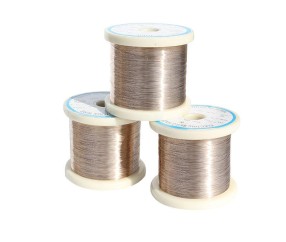Nichrome Wire: What is It? And What Are Its Uses?
Release time:2025-04-05 Strike:517 Inquire Now
What Is Nichrome?
Nichrome describes a family of metal alloys. These alloys contain, in varying quantities, chromium, iron and nickel as core ingredients. Other metals may also be present in minute quantities, depending on the specific purpose of a given nichrome alloy.
nichrome wire is simply a spooled length of nichrome alloy for use in a variety of industrial and scientific applications. The alloy possesses various innate qualities, which render it perfect for practical utility in electronics, engineering, manufacture and even medicine.

The Properties of Nichrome Wire
Nichrome as an alloy shares the oxidation resistance properties of chrome. Nichrome forms a thin oxide layer on its surface that seals the alloy from further oxidation and corrosion, rendering it fairly inert with regard to contact with moisture or varying pH levels. There are relatively few instances in which corrosion can occur properly, involving high-temperature acids and haloacids.
Nichrome is not only resistant to oxidation and corrosion, but also to heat. Nichrome can withstand temperatures well above 2000 degrees Fahrenheit, depending on the specific ratio of core metals in the alloy. This heat resistance combines with another key property to make nichrome particularly useful industrially: electrical resistance.
As nichrome provides high electrical resistance, heat energy can be generated quickly through the provision of electrical current. The high heat resistance means the nichrome can be electrically induced to heat itself to incredibly high temperatures.
Practical Uses of Nichrome Wire
The above properties make nichrome wire a widely useful component part, with practical applications across industries. It is perhaps most commonly used in laboratories as a form of remote ignition solution, to enable the carrying-out of dangerous experiments without proximal location to the reaction. Nichrome wire can be used to ignite compounds from beyond a fume-box, or at a distance.
Nichrome can also be used as an inert device for transferring samples from one place to another. Nichrome implements can lift biological materials and place them in petri dishes without reacting with the sample or corroding in the process.
Nichrome wire also has a number of commercial applications, being the core heating element that enables the function of household appliances. Conventional hair dryers, toasters and broilers use nichrome wire coils to achieve high heat levels. Bespoke heating and cutting tools also comprise nichrome coils.
Nichrome wire, an alloy primarily made of nickel and chromium, is extensively used for its high resistivity and ability to generate heat efficiently. Recent discussions in the tech and engineering communities highlight its applications in various fields, from household appliances to industrial furnaces. For instance, nichrome wire is crucial for heating elements in devices like toasters, hair dryers, and electric ovens. Its stable resistance and ability to withstand high temperatures also make it ideal for use in aerospace, automotive heating systems, and medical devices.
One notable application is in custom-built resistors, where nichrome wire's precise resistance characteristics are essential for controlling current. DIY enthusiasts and engineers often explore ways to use it in projects like thermal sensors and resistance heating setups. There's also interest in utilizing it for energy-efficient appliances, as nichrome's rapid heating and thermal stability help reduce energy consumption.
The versatility of nichrome wire continues to expand as engineers develop new techniques for optimizing its performance, such as annealing and cold working to adjust its properties for specific applications.

Exploring the Applications of Resistance Wire: From Industrial Heating to Electric Vehicles
Resistance wire is a specialized material widely used in various...

How does the air fryer get heated?
An air fryer gets heated using an electric heating element combi...

How does a Kettle heat water?
A kettle typically uses a metal coil heating element to heat wat...

How is resistance wire used in a hair dryer?
A resistance wire in a hair dryer is used as the heating element...


